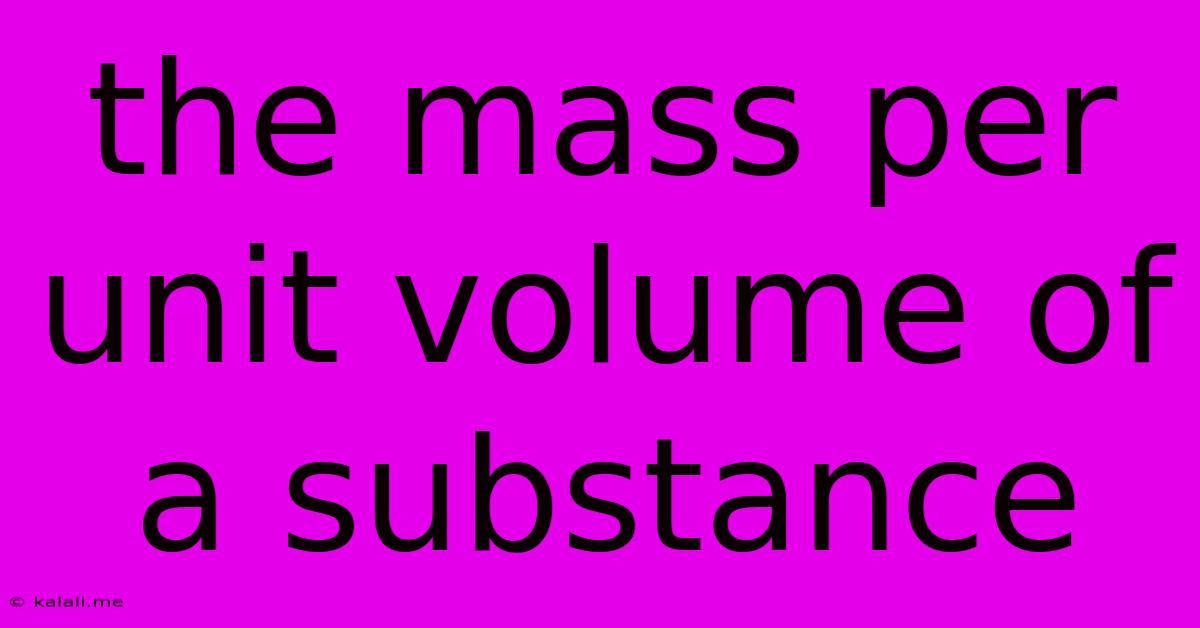The Mass Per Unit Volume Of A Substance
Kalali
Jun 14, 2025 · 3 min read

Table of Contents
Understanding Mass per Unit Volume: Density Explained
This article delves into the concept of mass per unit volume, more commonly known as density. Understanding density is crucial in various fields, from physics and chemistry to engineering and material science. We'll explore its definition, calculation, units, and practical applications. This comprehensive guide will equip you with a solid grasp of this fundamental property of matter.
Density describes how much mass is packed into a given volume of a substance. It's a measure of how tightly the particles of a substance are arranged. A high density means a lot of mass crammed into a small space, while a low density implies a more spread-out arrangement of mass.
Defining Density: Mass Over Volume
The formula for calculating density is straightforward:
Density (ρ) = Mass (m) / Volume (V)
Where:
- ρ (rho): Represents density. It's often expressed using the Greek letter rho.
- m: Represents mass, typically measured in kilograms (kg) or grams (g).
- V: Represents volume, commonly measured in cubic meters (m³) or cubic centimeters (cm³).
This equation tells us that density is directly proportional to mass and inversely proportional to volume. This means that if you increase the mass while keeping the volume constant, the density will increase. Conversely, if you increase the volume while keeping the mass constant, the density will decrease.
Units of Density
The units of density depend on the units used for mass and volume. Common units include:
- kg/m³ (kilograms per cubic meter): The SI unit for density.
- g/cm³ (grams per cubic centimeter): Frequently used in chemistry and for solids.
- g/mL (grams per milliliter): Often used for liquids.
- kg/L (kilograms per liter): Another common unit for liquids.
It's important to maintain consistency in units throughout your calculations to obtain accurate results. Converting between units might be necessary depending on the context of the problem.
Calculating Density: A Practical Example
Let's say we have a block of metal with a mass of 100 grams and a volume of 20 cubic centimeters. To calculate its density, we simply plug the values into the formula:
Density (ρ) = 100 g / 20 cm³ = 5 g/cm³
Therefore, the density of the metal block is 5 grams per cubic centimeter.
Factors Affecting Density
Several factors influence the density of a substance:
- Temperature: Generally, an increase in temperature leads to an expansion in volume, thus decreasing density. This is because the particles move farther apart as temperature rises.
- Pressure: Increasing pressure usually compresses the substance, reducing its volume and increasing its density.
- Composition: The types and arrangement of atoms or molecules within a substance significantly affect its density. Different materials have different densities.
Applications of Density
Understanding density is crucial in various applications:
- Material Identification: Comparing the density of an unknown substance to known values can help identify its composition.
- Fluid Mechanics: Density plays a vital role in understanding buoyancy, fluid flow, and pressure distribution in liquids and gases.
- Archimedes' Principle: This principle, related to buoyancy, directly utilizes the concept of density to determine whether an object will float or sink in a fluid.
- Geological Studies: Density measurements help geologists determine the composition and structure of rocks and minerals.
Conclusion
Density, the mass per unit volume of a substance, is a fundamental concept with broad applications across numerous scientific and engineering disciplines. By understanding its definition, calculation, and influencing factors, you can effectively utilize this property to solve problems and gain insights into the properties of matter. Mastering the concept of density opens doors to a deeper understanding of the physical world around us.
Latest Posts
Latest Posts
-
One Coulomb Equals How Many Electrons
Jun 14, 2025
-
In A School Containing 360 Students
Jun 14, 2025
-
Which Of The Following Is Not A Type Of Joint
Jun 14, 2025
-
A Small River That Joins A Larger River Is A
Jun 14, 2025
-
Which Of The Following Are Mechanical Waves
Jun 14, 2025
Related Post
Thank you for visiting our website which covers about The Mass Per Unit Volume Of A Substance . We hope the information provided has been useful to you. Feel free to contact us if you have any questions or need further assistance. See you next time and don't miss to bookmark.